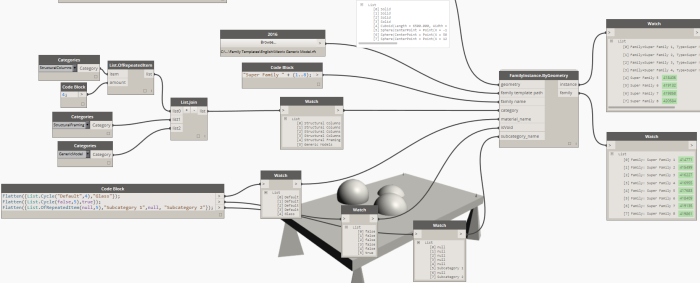This node converts a Dynamo surface, poly-surface or solid into a Revit family. It then places an instance of that family inside your project, reflecting the geometry position from inside Dynamo. It currently supports Revit 2014 to 2016.

The most important inputs are:
- The geometry objects
- A file path to a family template (It is crucial that the family template version matches your Revit version)
- A unique family name for each geometry object
The optional inputs are:
- Category. The default value is Generic Model. Some templates, like the conceptual mass, do not allow changes to the family category. In those cases the built-in category will remain in force.
- Material of the family, provided as a string. The material must be pre-loaded into the template for this option to take effect. If a material with such a name does not exist in the template, the default “By Category” material will be used.
- Void switch provided as a Boolean ( true / false). The default value is set to false. If you provide a true value, the newly created family will act a void cut element and will be able to perform cuts on structural elements, generic model elements and host elements.
- Subcategory provided as a string. The default value is null – meaning that this option is ignored. If you provide a subcategory name, it will be generated inside the family document, applied to the family and added to the project together with it.

Do note that by default, the node works in “longest” lacing. That means that if any of the optional inputs are less than the geometry objects and the family names, the last input will be used for all remaining families. In the above image, the families at [6] and [7] will belong to the “Generic Model” category and will act as void cuts.
You can download this sample and others from the Spring Nodes repository:
https://github.com/dimven/SpringNodes/tree/master/Samples
Currently the node does not place multiple geometries into a single family. There is a partial workaround described in the following discussion:
https://github.com/dimven/SpringNodes/issues/10
A node for such cases might be developed in the future.

5 thoughts on “FamilyInstance.ByGeometry”